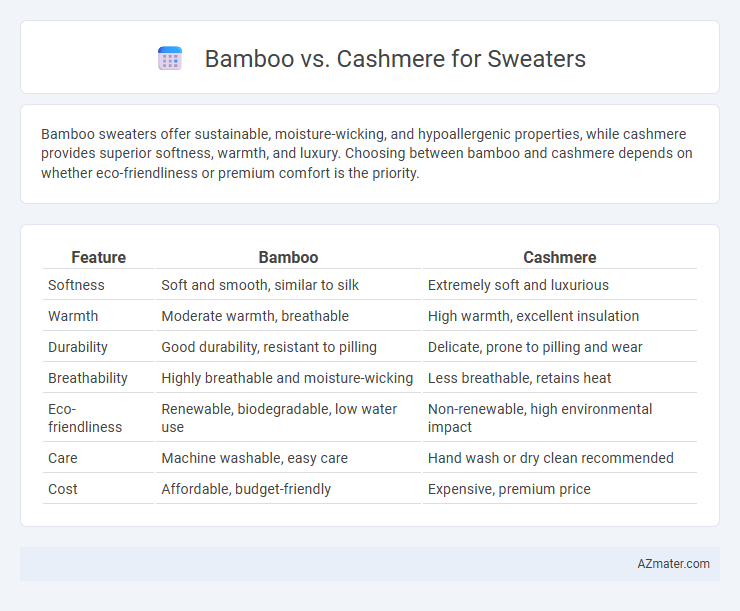Bamboo sweaters offer sustainable, moisture-wicking, and hypoallergenic properties, while cashmere provides superior softness, warmth, and luxury. Choosing between bamboo and cashmere depends on whether eco-friendliness or premium comfort is the priority.
Table of Comparison
| Feature | Bamboo | Cashmere |
|---|---|---|
| Softness | Soft and smooth, similar to silk | Extremely soft and luxurious |
| Warmth | Moderate warmth, breathable | High warmth, excellent insulation |
| Durability | Good durability, resistant to pilling | Delicate, prone to pilling and wear |
| Breathability | Highly breathable and moisture-wicking | Less breathable, retains heat |
| Eco-friendliness | Renewable, biodegradable, low water use | Non-renewable, high environmental impact |
| Care | Machine washable, easy care | Hand wash or dry clean recommended |
| Cost | Affordable, budget-friendly | Expensive, premium price |
Introduction to Bamboo and Cashmere Sweaters
Bamboo sweaters are crafted from bamboo fibers, known for their natural softness, breathability, and moisture-wicking properties, making them ideal for sensitive skin and warm climates. Cashmere sweaters, made from the fine undercoat of cashmere goats, boast exceptional warmth, lightweight comfort, and a luxurious texture highly prized in cold weather fashion. Both materials offer distinct benefits, with bamboo emphasizing sustainability and breathability, while cashmere prioritizes insulation and luxury.
Sustainability and Environmental Impact
Bamboo sweaters offer a highly sustainable alternative due to bamboo's rapid growth and low water requirements, reducing environmental strain compared to traditional fibers. Cashmere production often involves overgrazing by goats, leading to soil erosion and habitat degradation, which raises significant ecological concerns. Choosing bamboo not only supports eco-friendly farming practices but also helps minimize carbon footprint and water consumption in textile manufacturing.
Softness and Comfort Comparison
Bamboo fiber offers exceptional softness that rivals cashmere, with a smooth texture that feels gentle against the skin, making it a popular choice for sensitive skin types. Cashmere is renowned for its luxurious softness derived from the fine undercoat of cashmere goats, providing unmatched warmth and a cozy feel. While cashmere excels in warmth retention, bamboo fabric boasts superior moisture-wicking and breathability, enhancing overall comfort in various climates.
Breathability and Moisture-Wicking Properties
Bamboo fabric exhibits superior breathability and moisture-wicking properties compared to cashmere, making it ideal for sweaters designed to keep the skin dry and cool. Its natural micro-gaps allow for optimal air circulation, effectively regulating body temperature during wear. While cashmere offers warmth and softness, bamboo's enhanced moisture management ensures greater comfort in varying climates.
Warmth and Insulation Abilities
Bamboo fabric offers moderate warmth with natural breathability and moisture-wicking properties, making it suitable for mild to cool weather. Cashmere excels in insulation due to its fine, dense fibers that trap heat effectively, providing superior warmth during colder conditions. While bamboo sweaters are lightweight and temperature-regulating, cashmere delivers unparalleled thermal comfort for winter wear.
Durability and Longevity
Bamboo sweaters offer high durability due to their natural strength and moisture-wicking properties, resisting pilling and maintaining shape over time. Cashmere, while luxuriously soft, requires more delicate care to prevent fiber damage and pilling, which can reduce its lifespan. Choosing bamboo ensures long-lasting wear with minimal maintenance, whereas cashmere provides comfort at the cost of more cautious handling to maintain longevity.
Allergen and Sensitive Skin Friendliness
Bamboo fabric is highly suitable for sensitive skin due to its natural hypoallergenic and antibacterial properties, which reduce irritation and allergic reactions. Cashmere, while soft and luxurious, can sometimes cause itchiness or allergic responses in people with sensitive skin because of its fine animal fibers. Choosing bamboo sweaters offers a more skin-friendly option, especially for those prone to allergies or skin sensitivities.
Care, Maintenance, and Cleaning
Bamboo sweaters require gentle washing in cold water and air drying to maintain their softness and prevent shrinkage, while cashmere sweaters need careful hand washing with special cashmere detergent and flat drying to avoid stretching. Both fabrics benefit from storage in breathable garment bags and avoiding direct sunlight to preserve fiber quality. Regular pilling removal using a cashmere comb or fabric shaver helps extend the lifespan of these delicate sweaters.
Style, Appearance, and Color Retention
Bamboo sweaters offer a smooth, silky finish with a natural sheen that highlights vibrant colors and maintains their brightness after multiple washes. Cashmere sweaters provide a luxurious, soft texture and a classic matte look, often available in rich, muted tones that age gracefully over time. Bamboo fibers excel in color retention due to their moisture-wicking properties, while cashmere's natural softness can sometimes lead to slight fading with frequent wear.
Price, Value, and Accessibility
Bamboo sweaters typically offer a more affordable price point compared to cashmere, making them accessible to a broader range of consumers. Cashmere, prized for its luxurious softness and insulation, carries a higher cost but delivers exceptional value through durability and premium quality. While bamboo garments provide sustainable benefits and breathability, cashmere remains a top choice for those prioritizing luxury and long-term investment in colder climates.

Infographic: Bamboo vs Cashmere for Sweater
 azmater.com
azmater.com